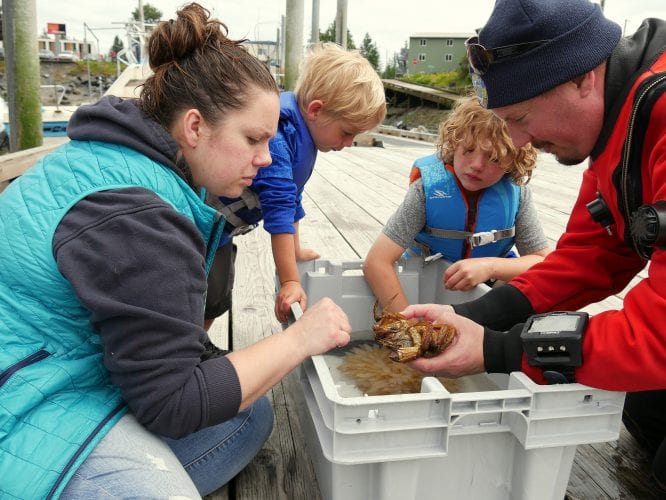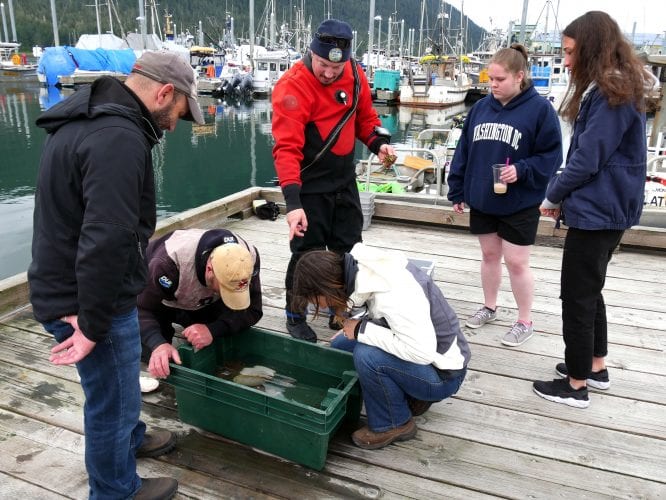
ADF&G crab biologist, Joe Stratman, shows a crab to Shauna Pitta-Rosse and her sons, Marek, 4, and Kostas, 9. Photo/Angela Denning
Children and adults alike are huddling around small totes on the dock at Petersburg’s North Harbor. The plastic containers are full of creatures crawling around in sea water. They were brought to the surface by divers with the Alaska Department of Fish and Game.
There’s a variety of animals–sea stars, urchins, scallops, a tiny octopus, all kinds of crabs…and something else rather peculiar. It looks like a large white-ish sea plant with pod-shaped branches.
“These are squid eggs actually,” said Joe Stratman, a biologist with ADF&G.
Stratman is on the dock wearing a red and black dry suit. He manages crab fisheries in Southeast Alaska but once a year gets a chance to do some diving too.
“I’ve never seen these before,” Stratman said. “It almost looks like an anemone but it’s just a collection of squid eggs.”
Also showing off the sea life today is Dive Safety Officer, Jeff Meucci. He shows some children the difference between two sea urchins.
“This one here is related to these guys but these guys live in the harbors and this one lives out at the ocean,” Meucci said.
Meucci is the one who found the squid eggs. He’s been diving for the State for 17 years.
“I’ve never seen it before where there are thousands and thousands of squid, male and females coming together mating and laying all these eggs. The whole sea floor was just covered with all of these skeins of squid eggs,” Meucci said. “It’s just really cool.”
Meucci supervises state diving in Southeast from British Columbia to Yakutat. He works out of the state research vessel Kestrel. He dives mostly near Ketchikan, Sitka, and Craig doing stock assessments for geoducks, sea cucumbers, and red urchins. That information determines what can be harvested in the fall fisheries. In the spring he’s checking on herring.

ADF&G diver Jeff Meucci (in yellow hat) and ADF&G biologist Joe Stratman (in red and black dry suit) show sea life to the public at the North Harbor dock. Photo/Angela Denning
More recently, the state divers have started working with a science center in Sitka to research how many abalone sea snails are in Southeast. The species was harvested back in the 80s and 90s and researchers want a baseline population.
The divers are also collaborating with the Smithsonian Environmental Research Center to study some new invasive species. One is the green crab south of Ketchikan and another is something known as tunicates found near Sitka.
“It’s like a sponge. It covers everything,” Meucci said. “It’s not natural to Southeast Alaska but they were brought in somehow into Whiting Harbor and they have started to cover all the rock and the kelp and I think what people are concerned about is that we don’t want that invasive species to impact any of the habitat that the herring might be spawning on.”
Meucci and other divers are helping to find ways to safely eradicate the tunicates in the harbor.
But aside from researching specific species, one of Meucci’s favorite things to do is share sea creature science with the public.
“These are things that are all around us,” Meucci said. “Like I said, I’ve been doing this for 17 years and I’m still excited to get back in the water every morning. I can hardly wait to get in the water. I get wore out the end of a trip but I’m very fortunate, I love what I do.”
Meucci knows most people don’t have access to the sea like he does. And he enjoys helping them get at least a peek at that underwater world.











